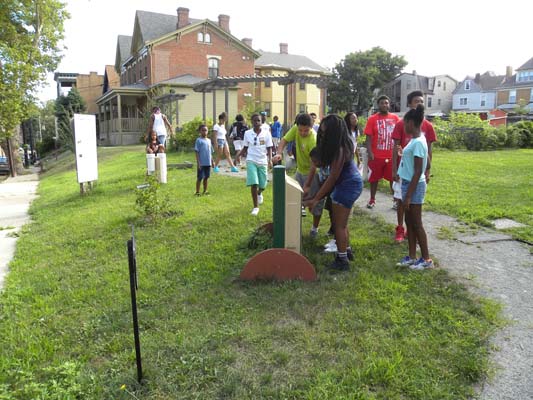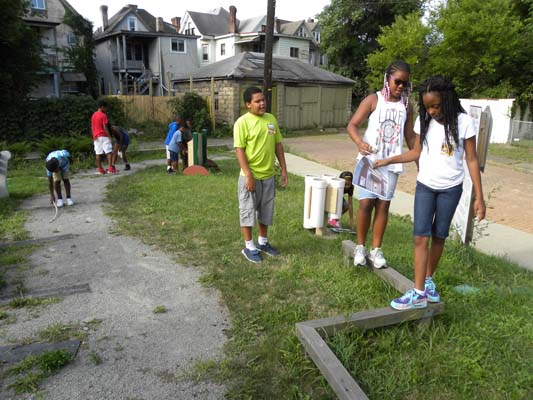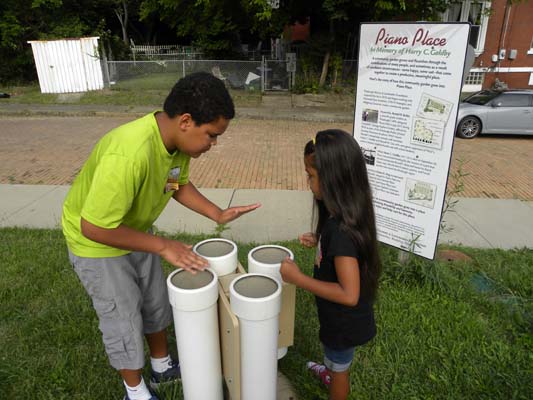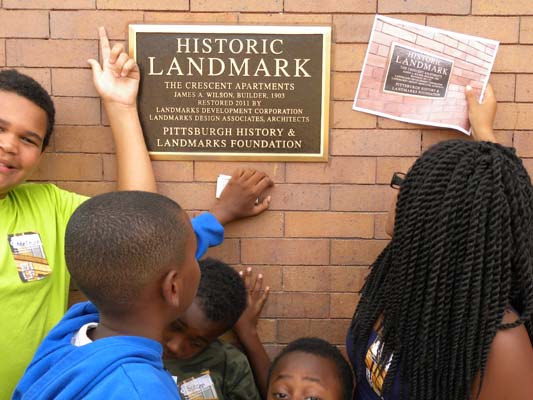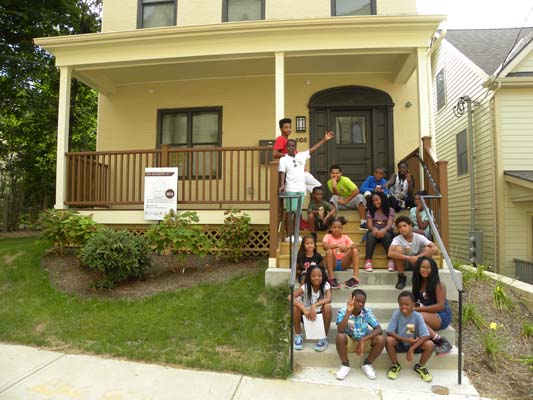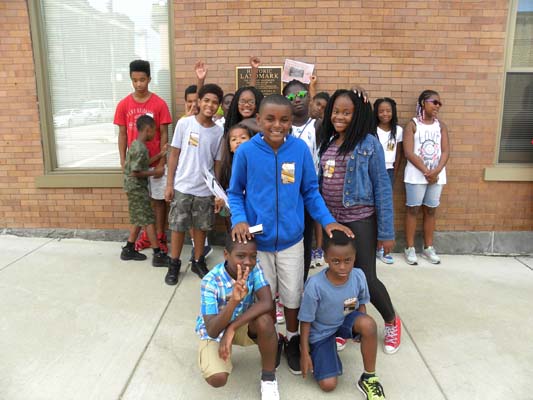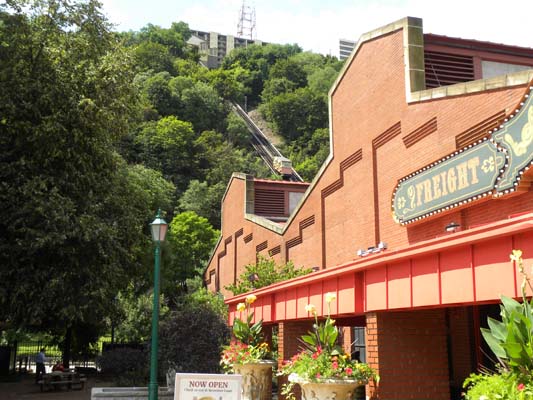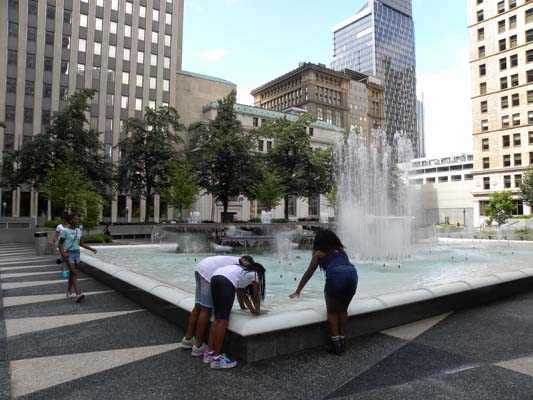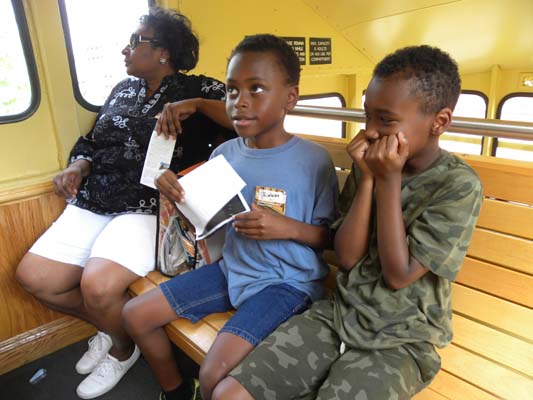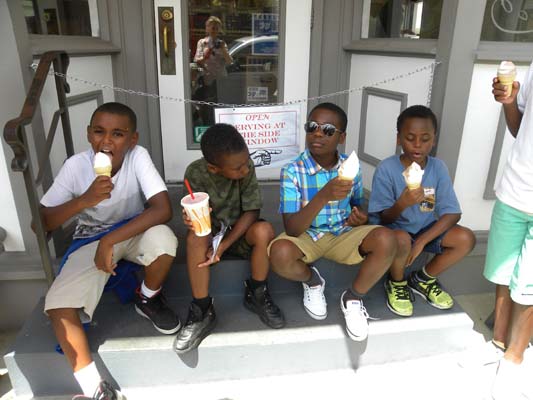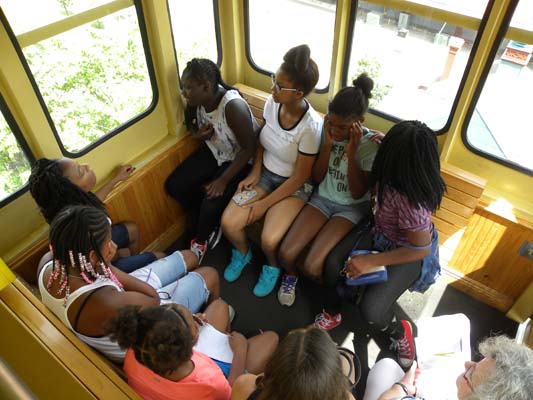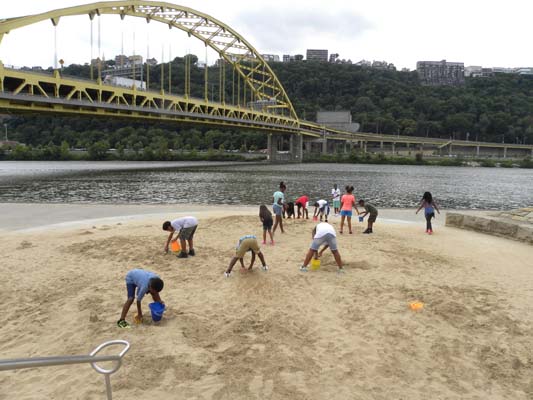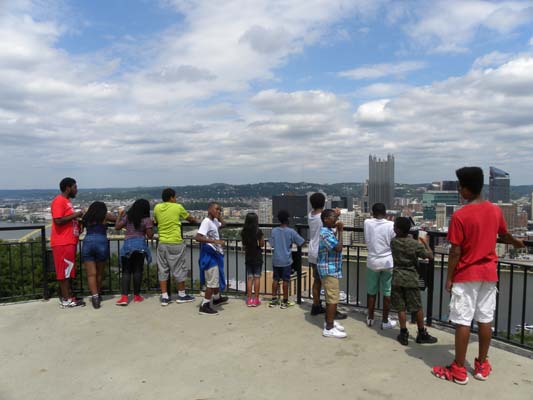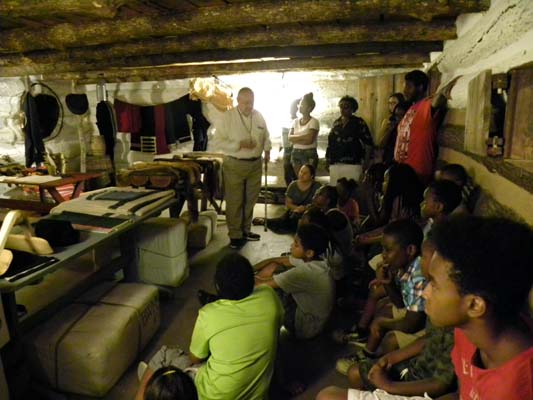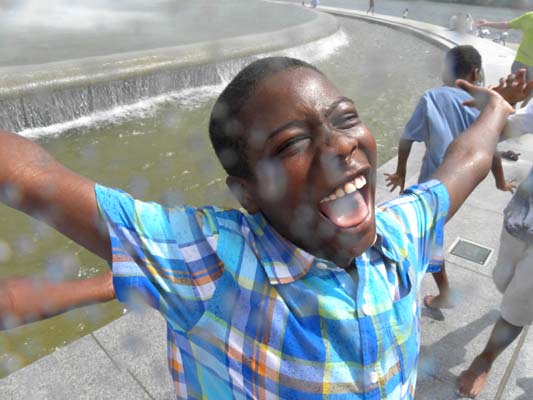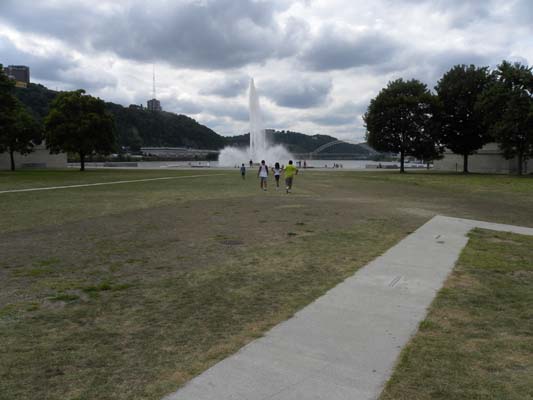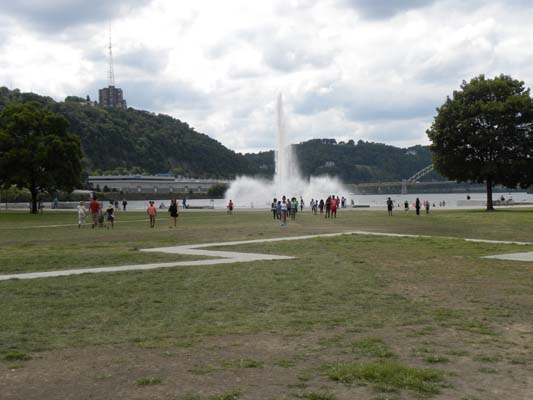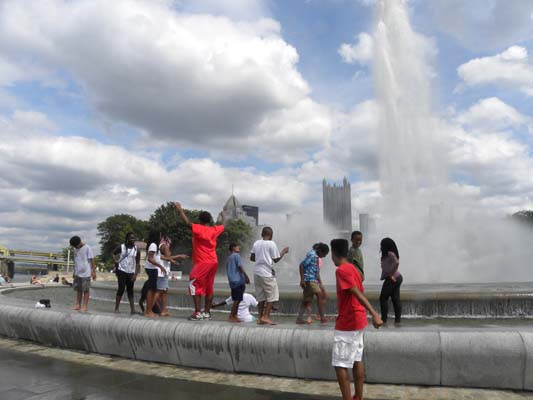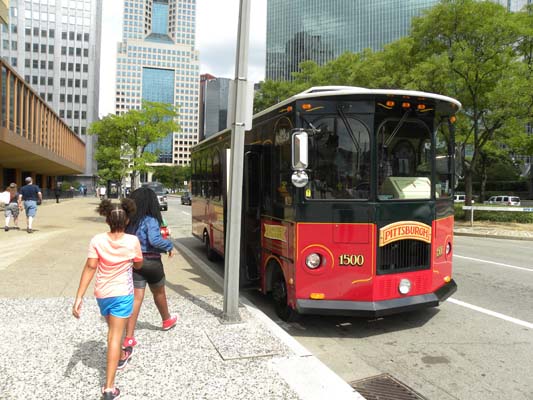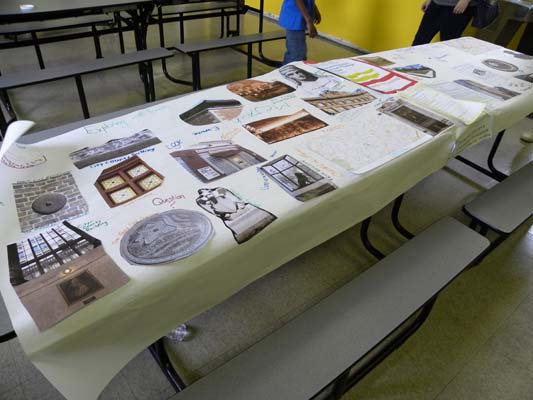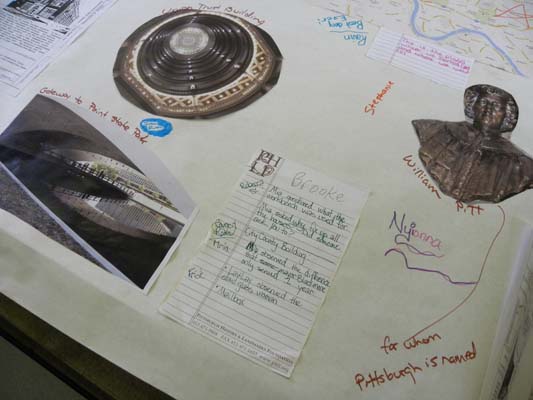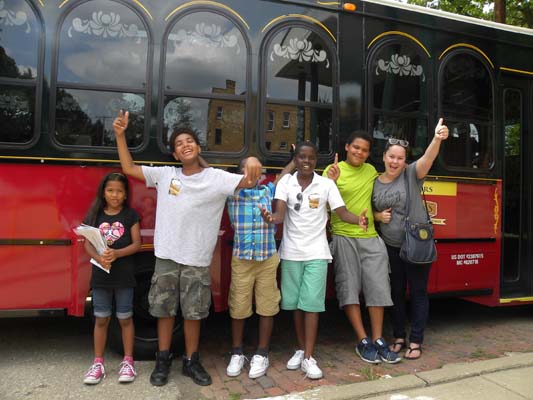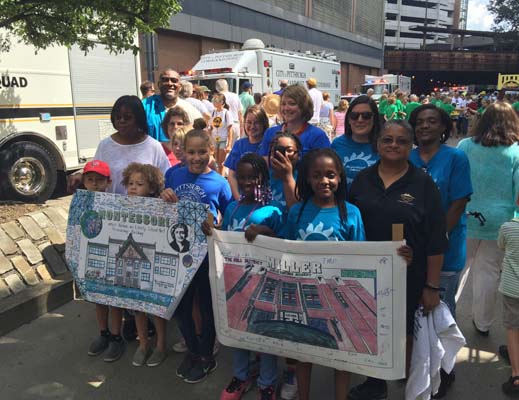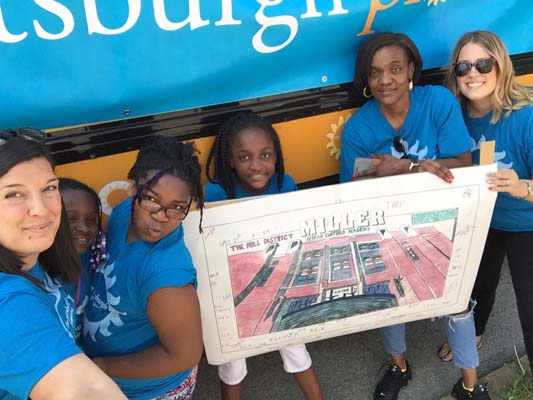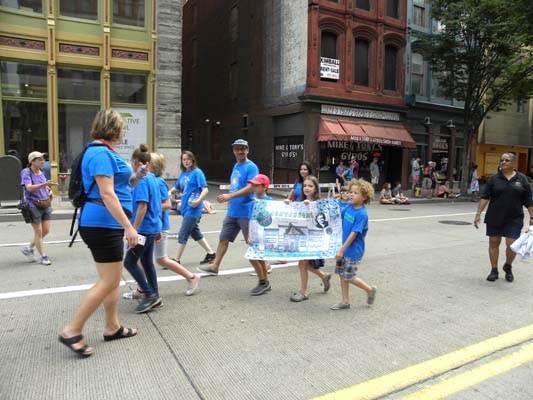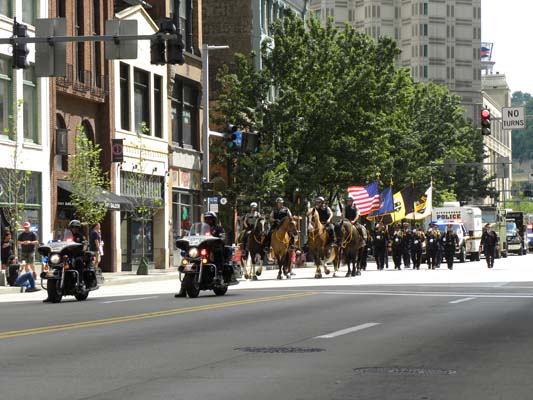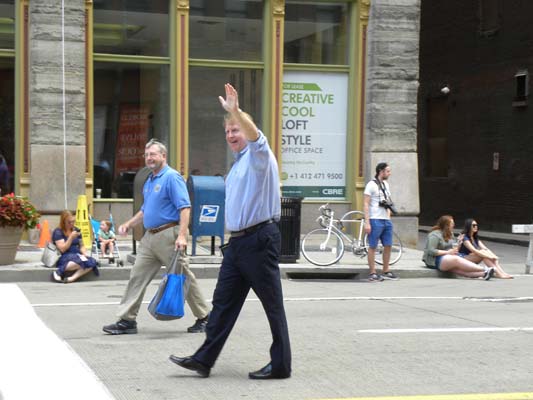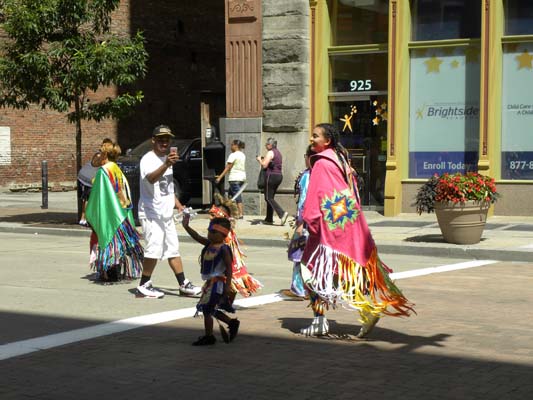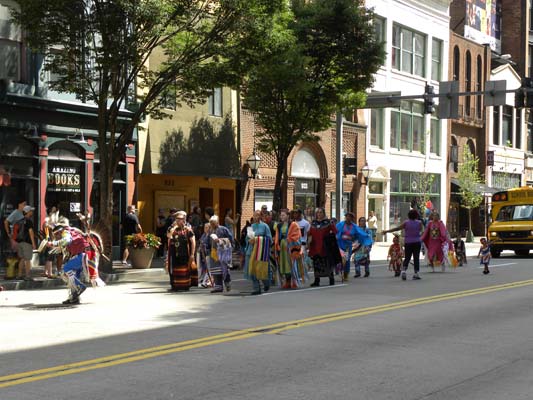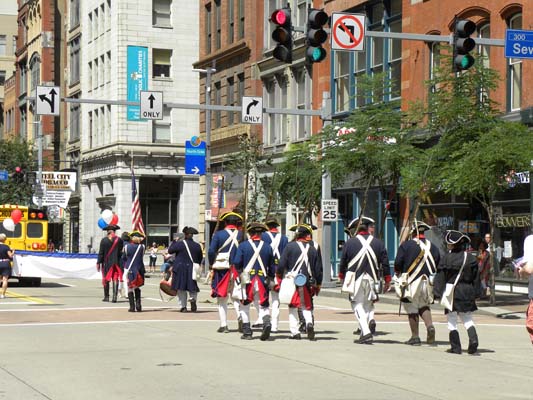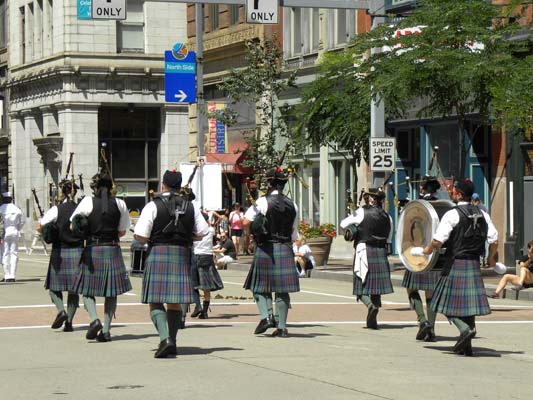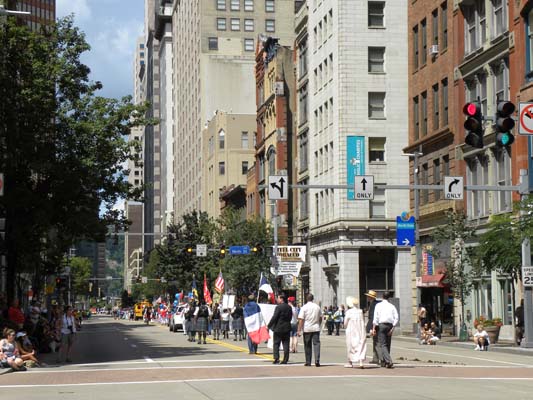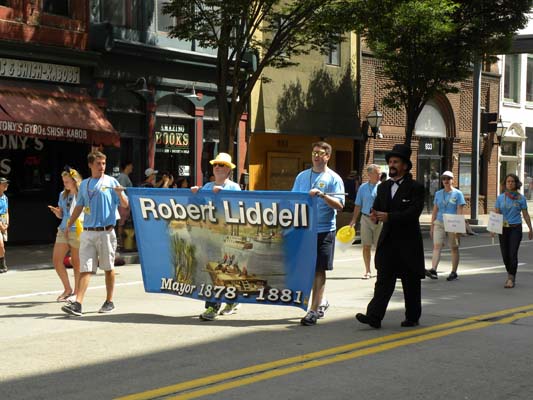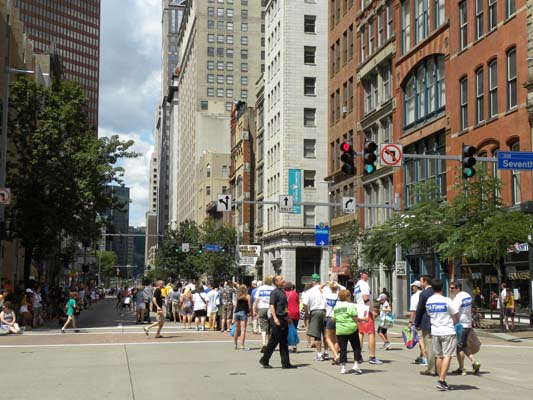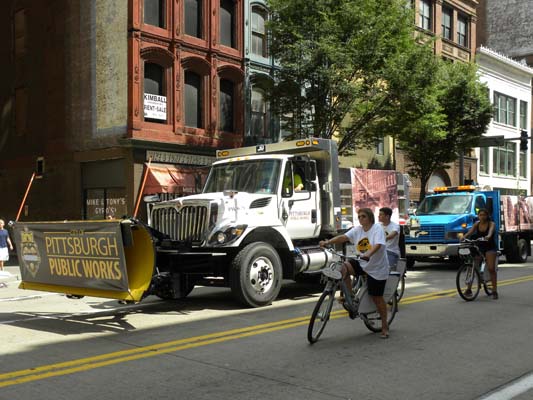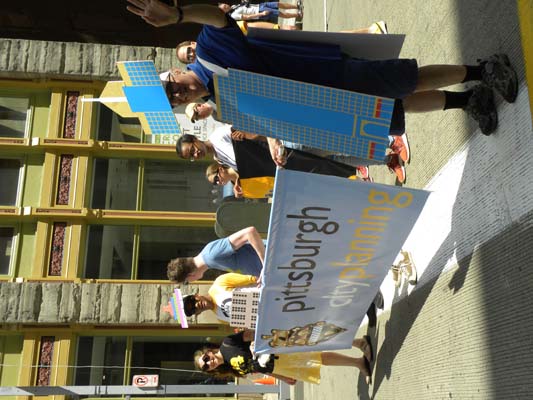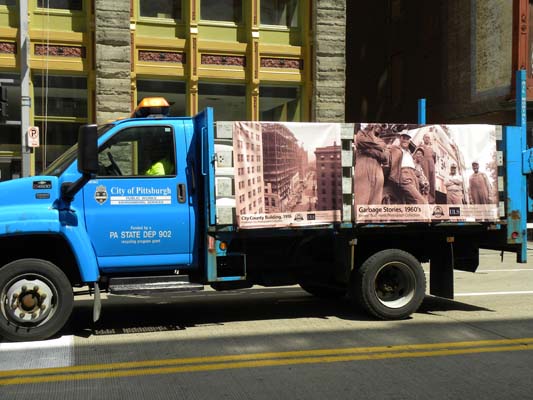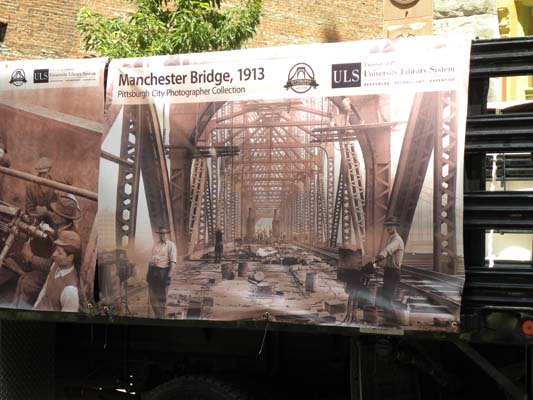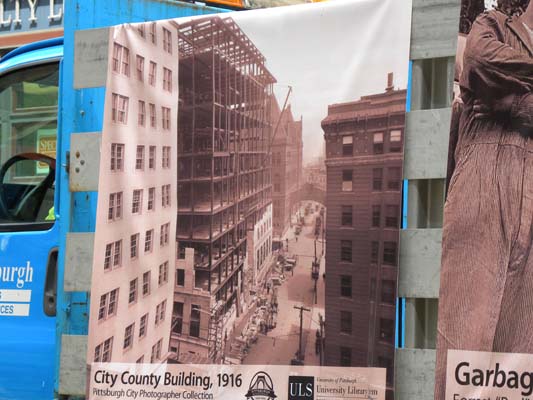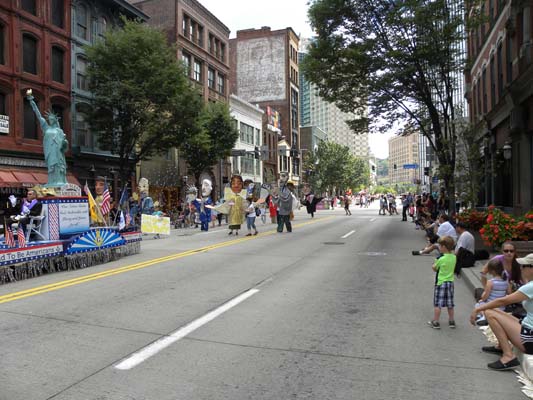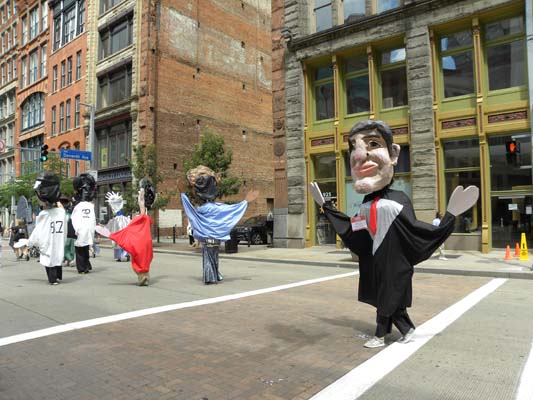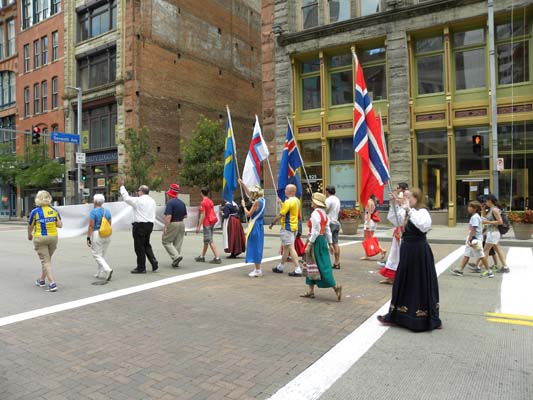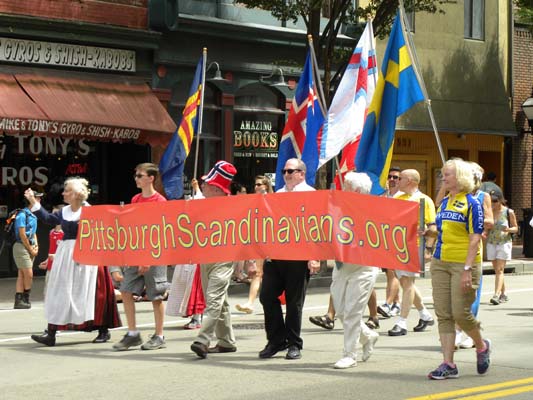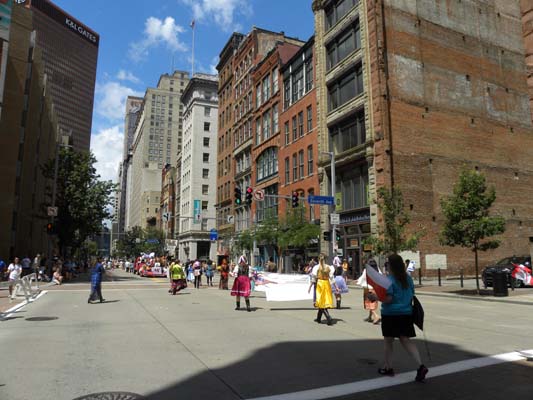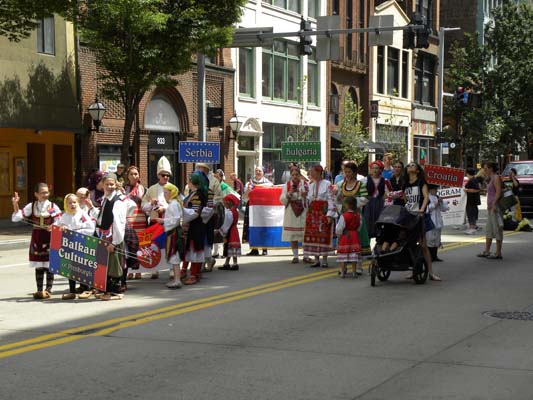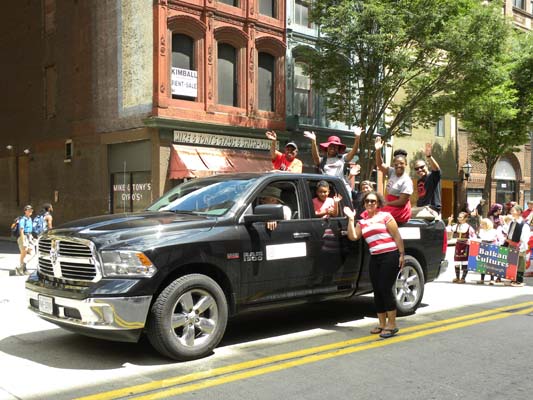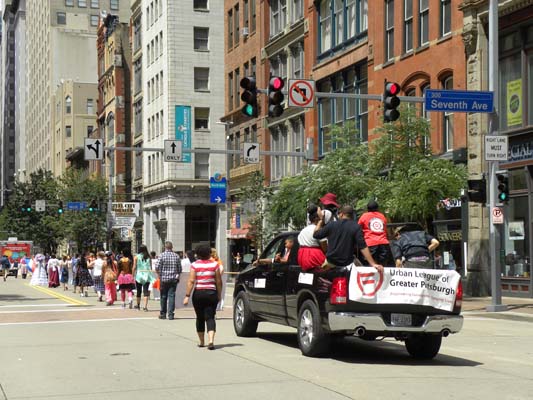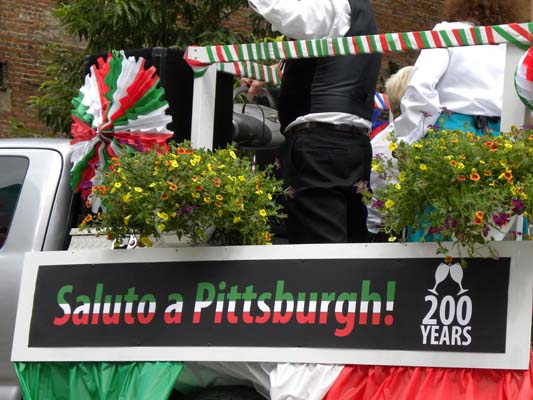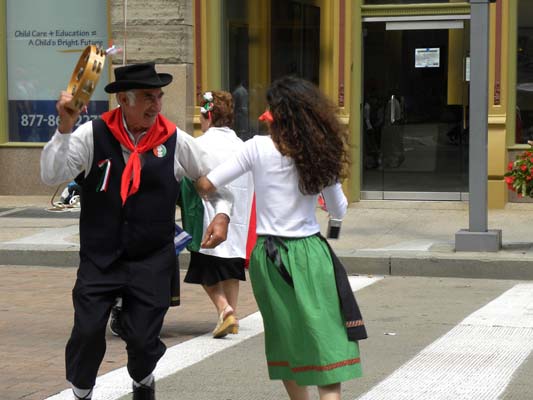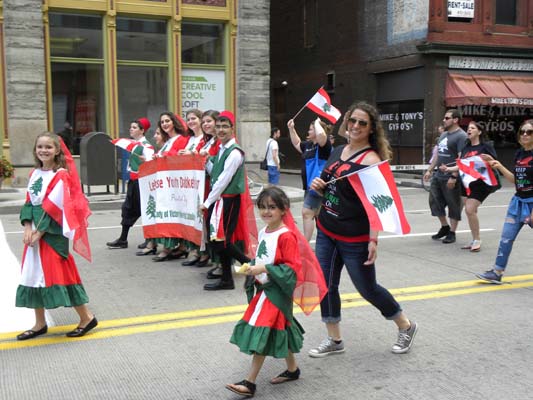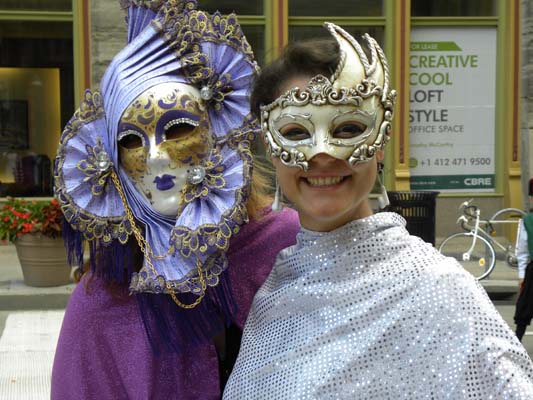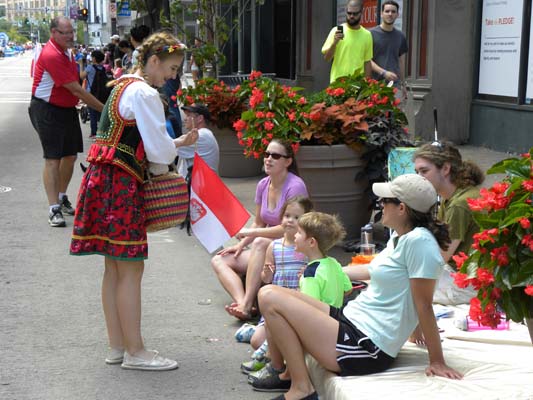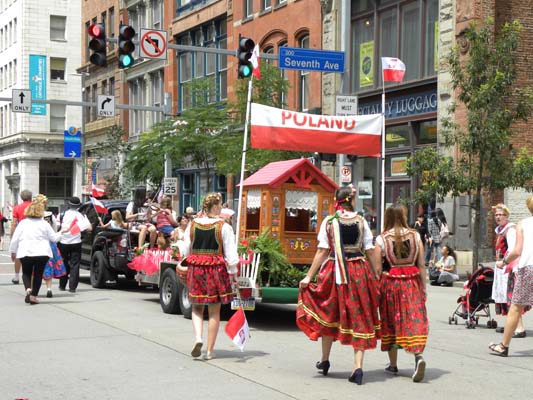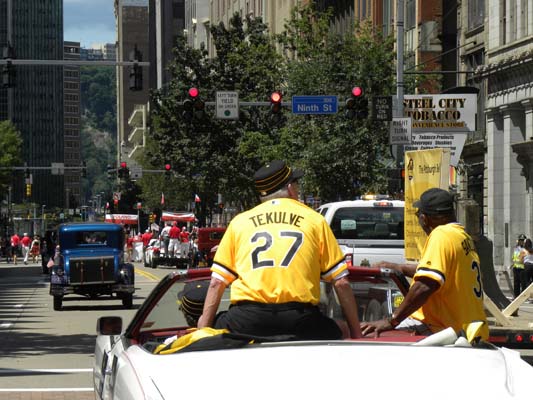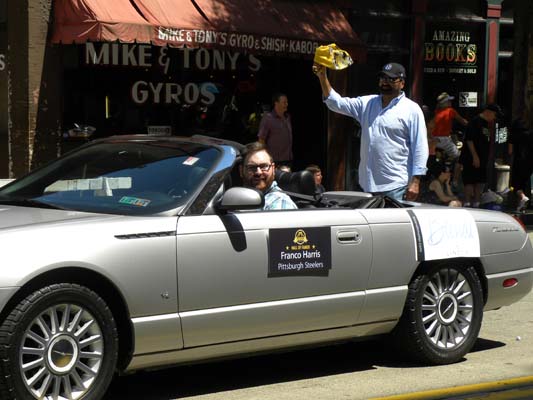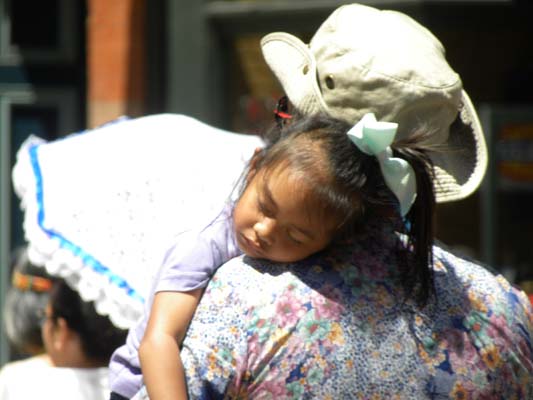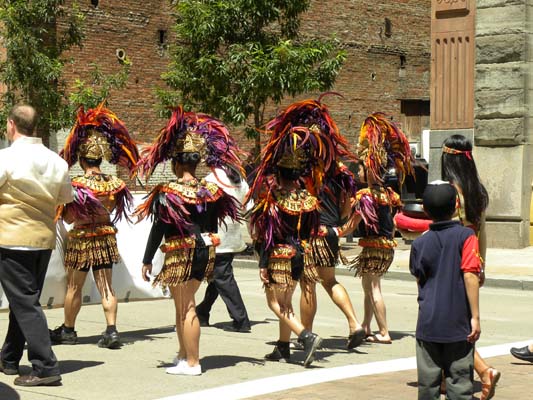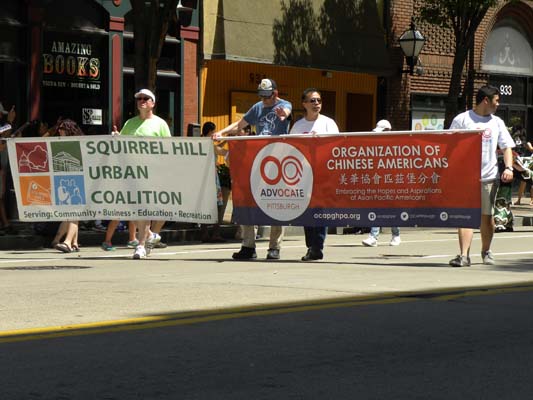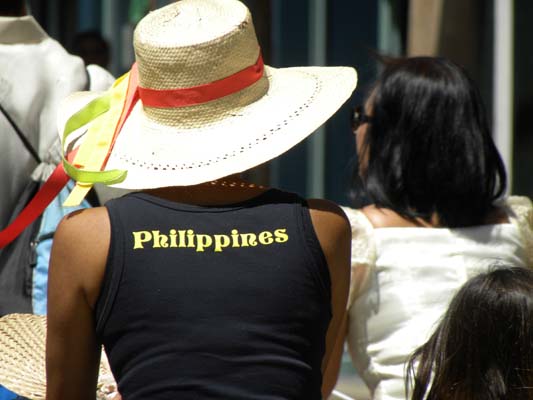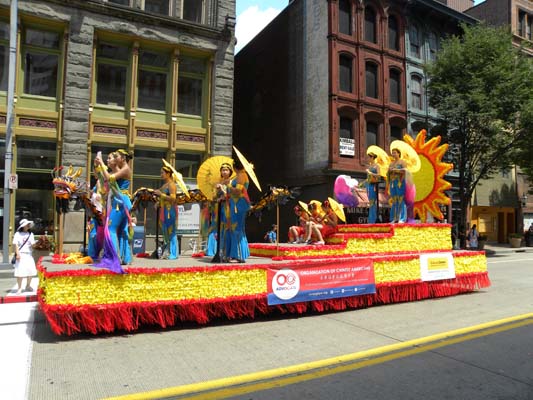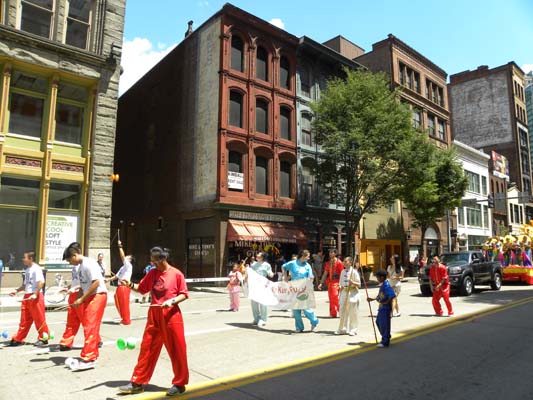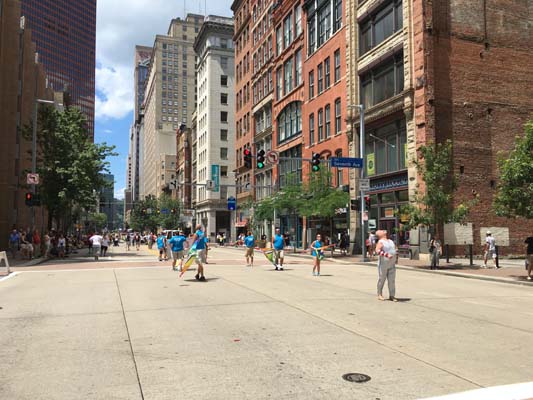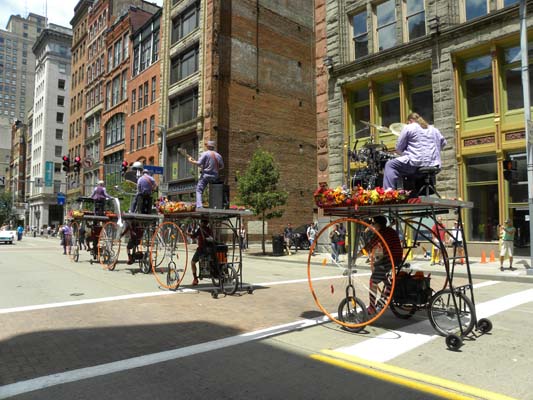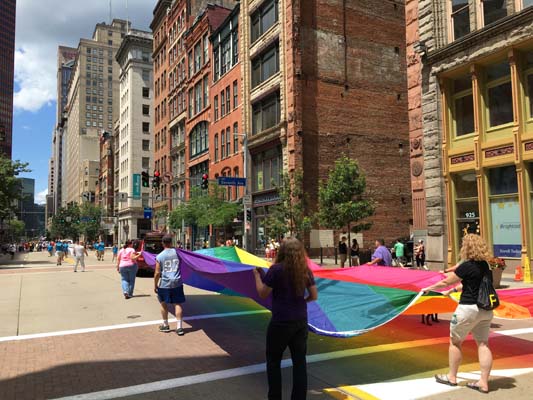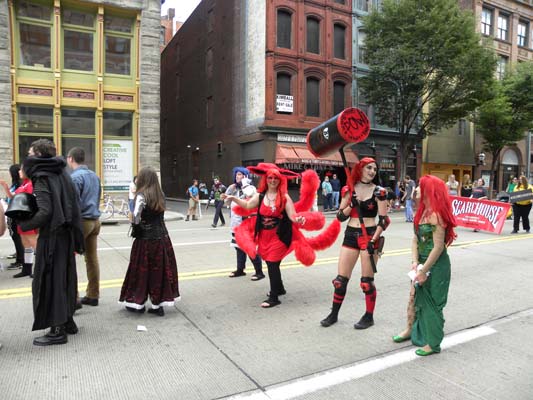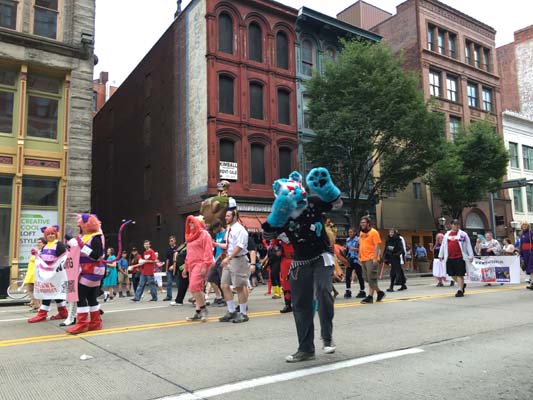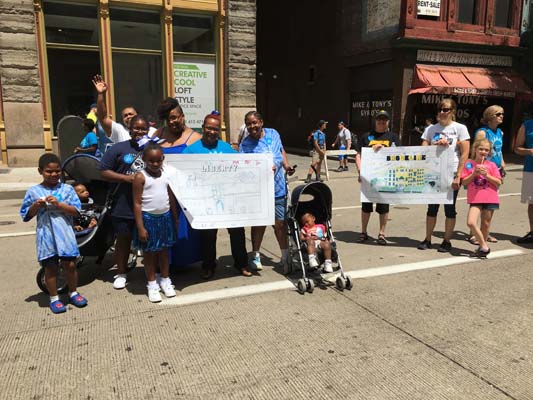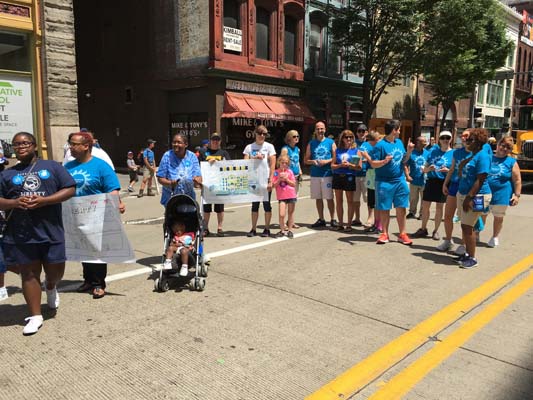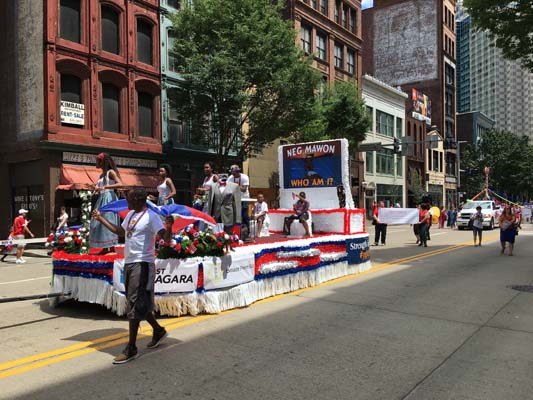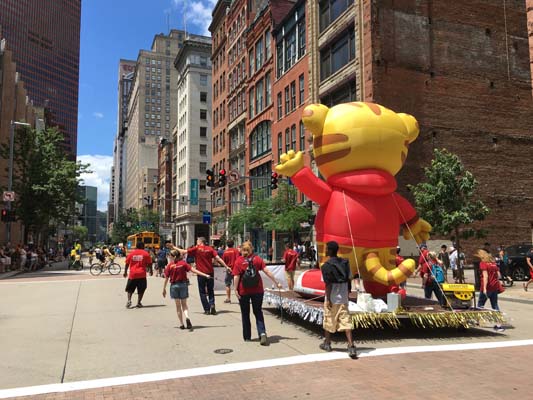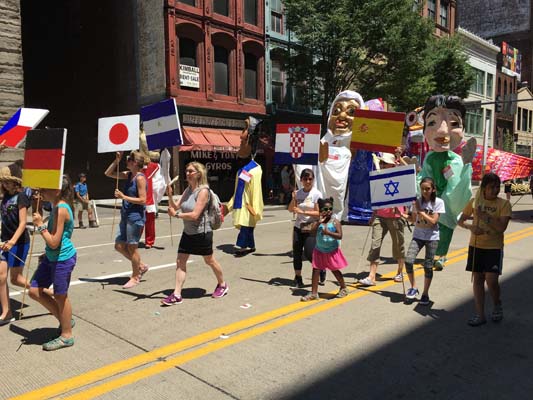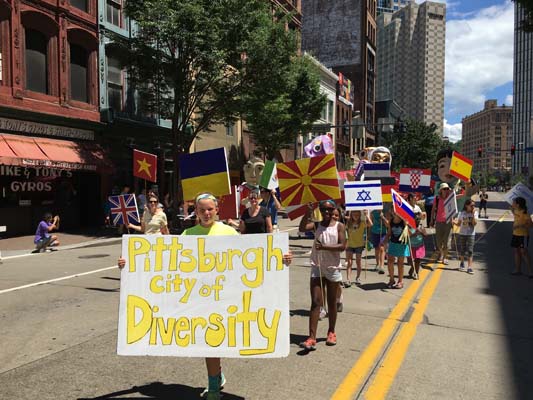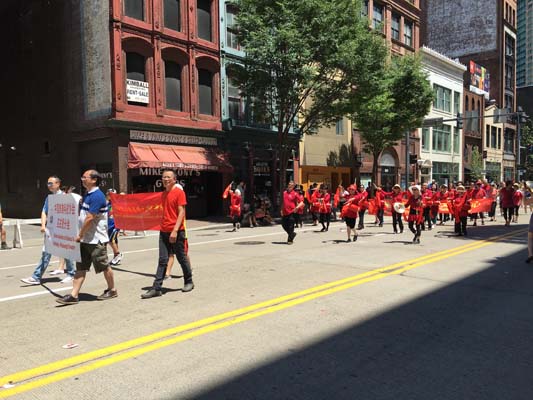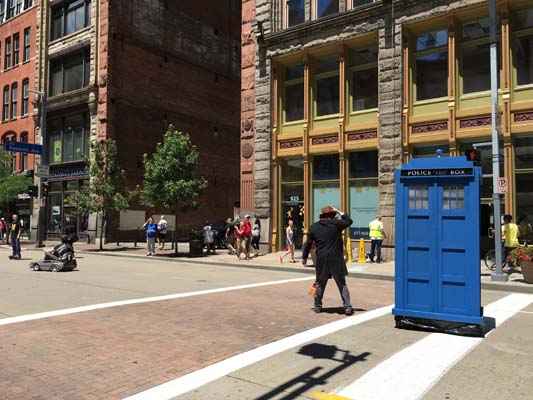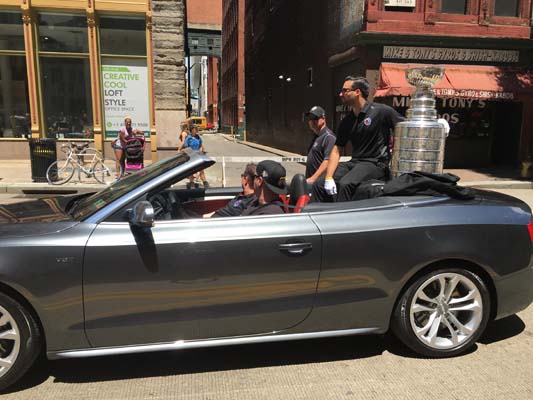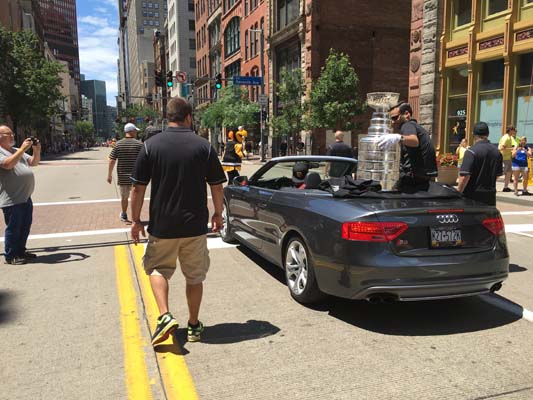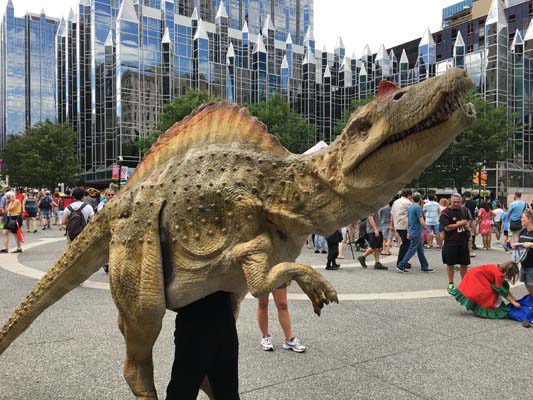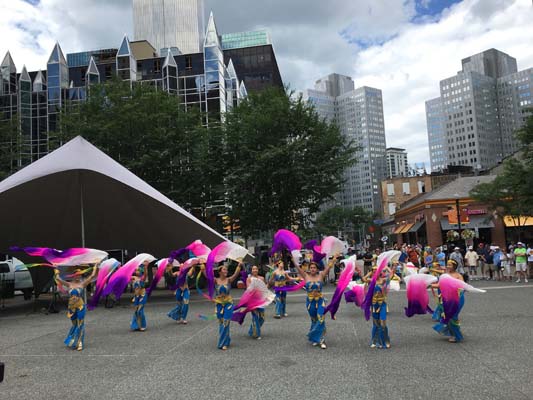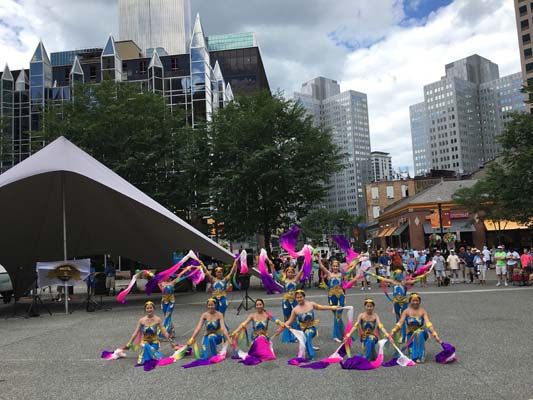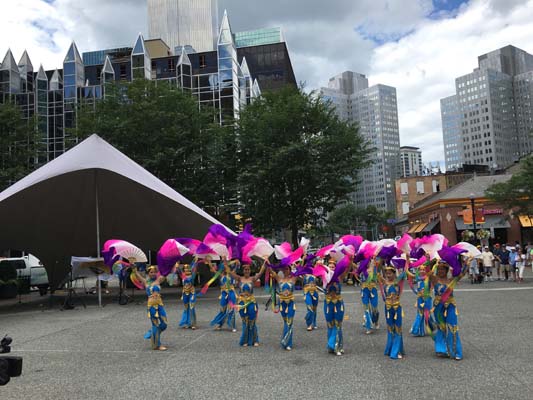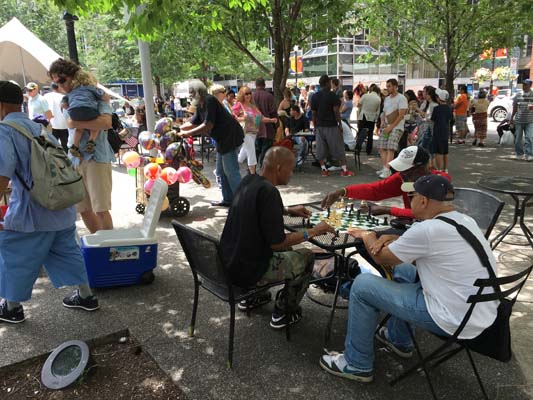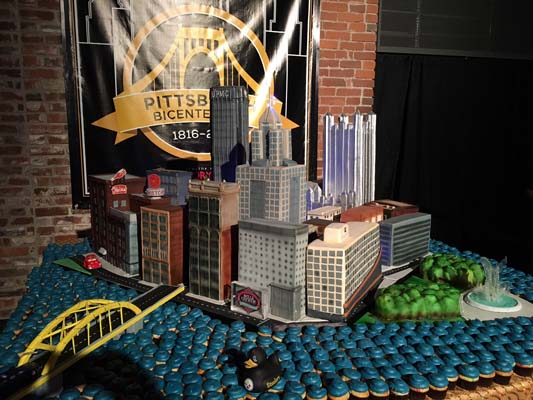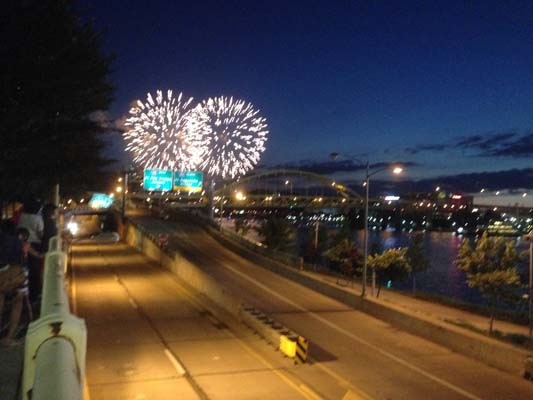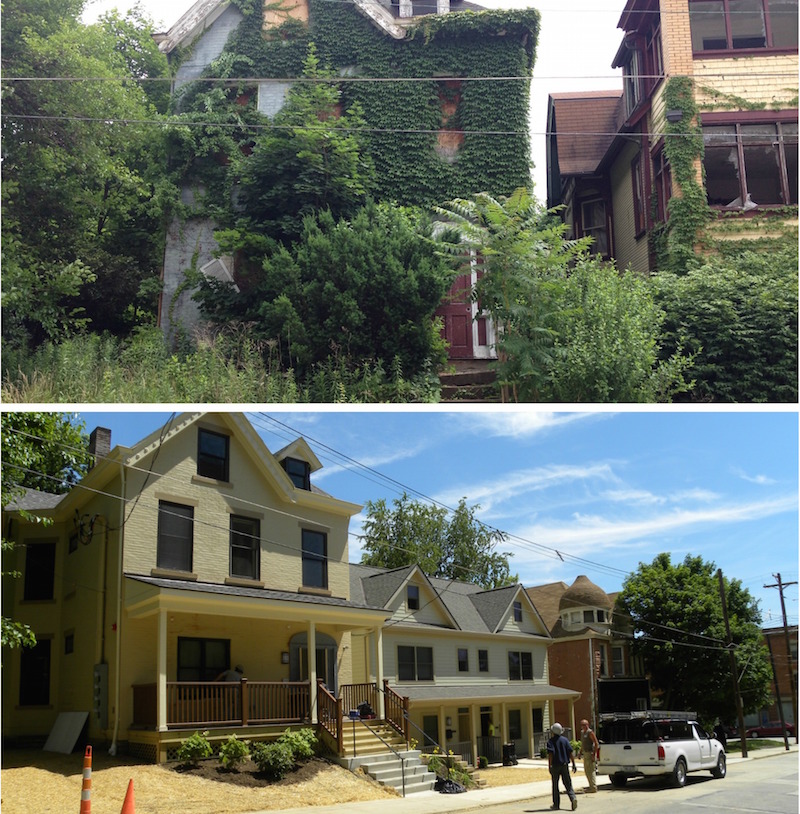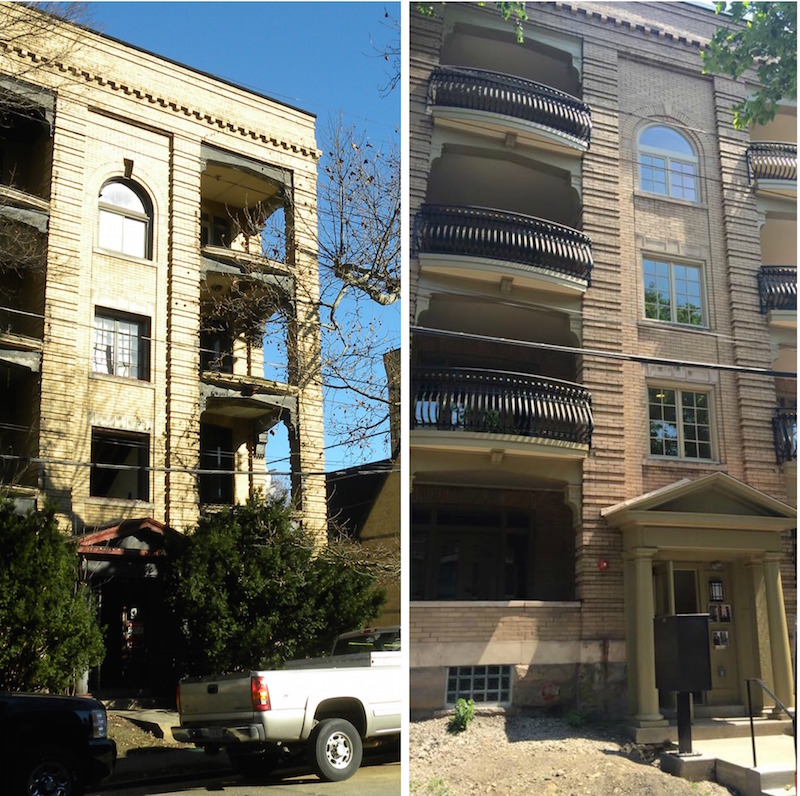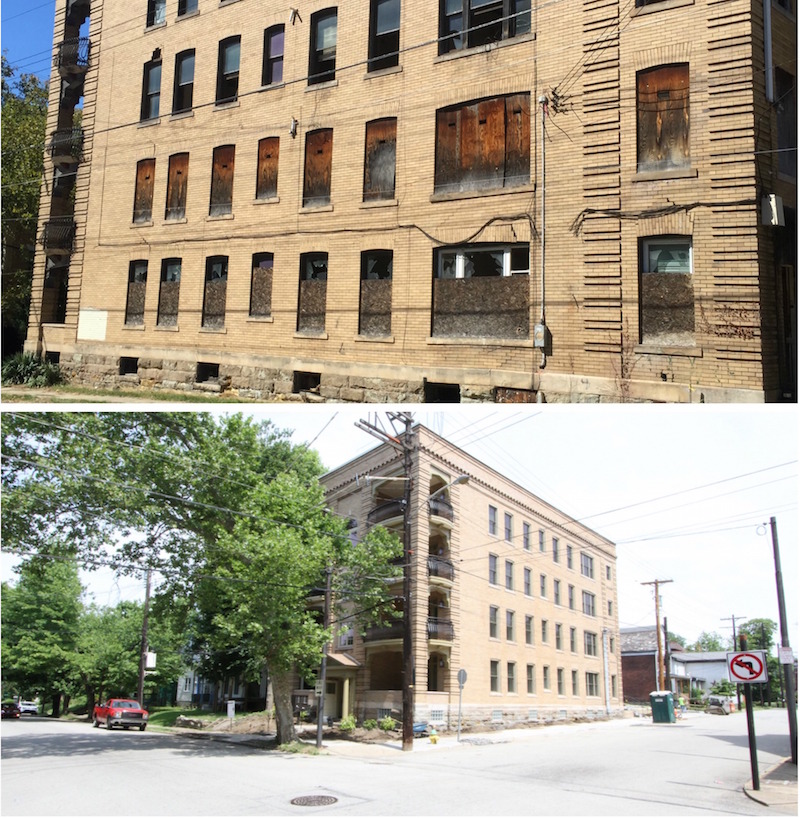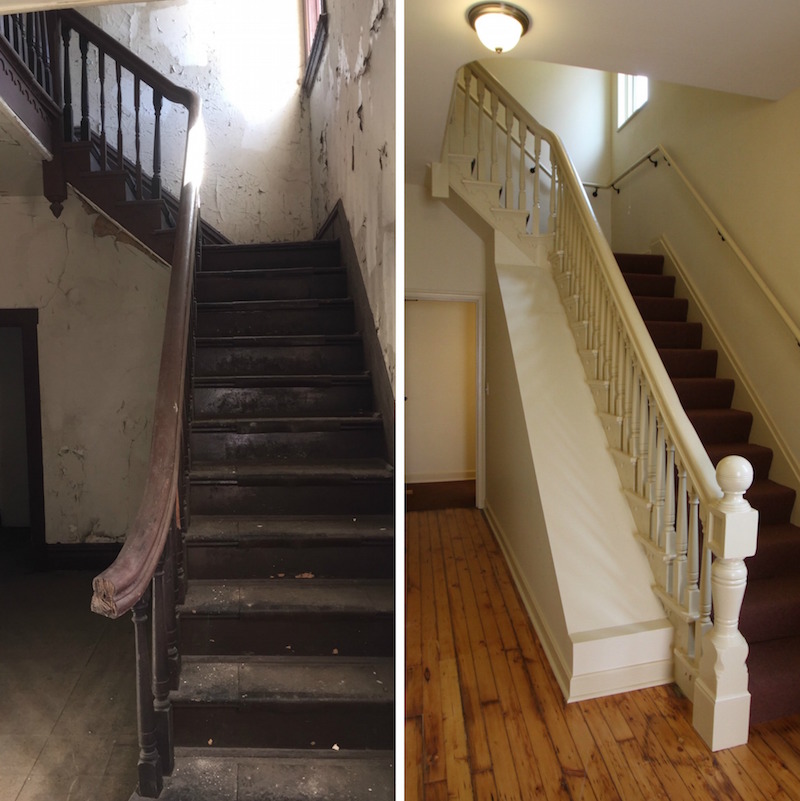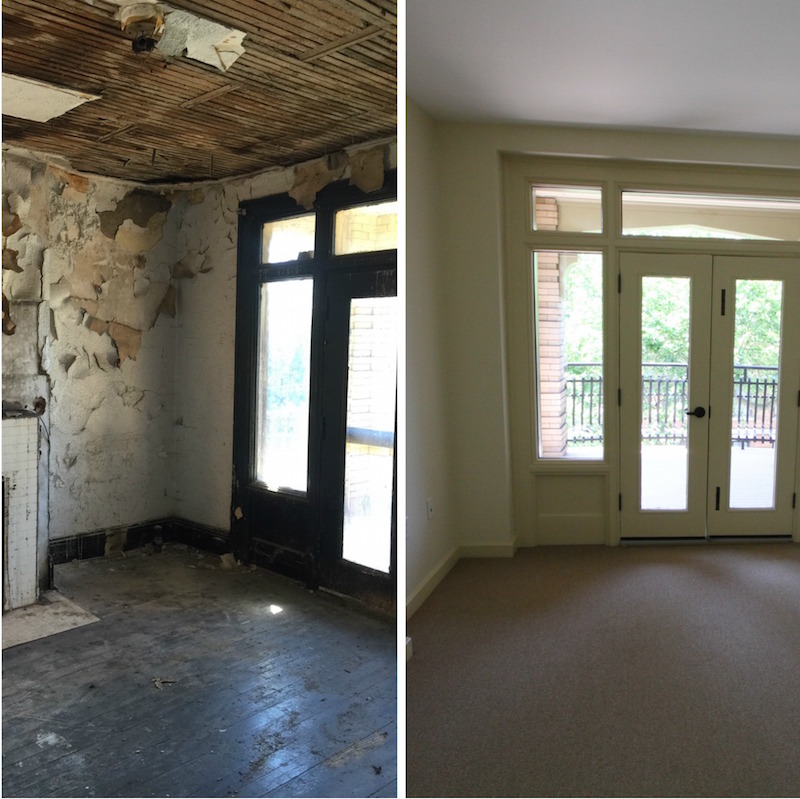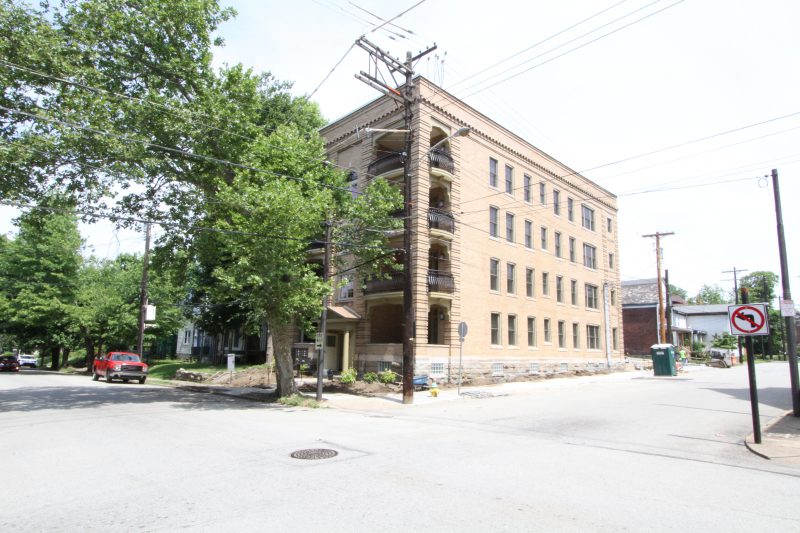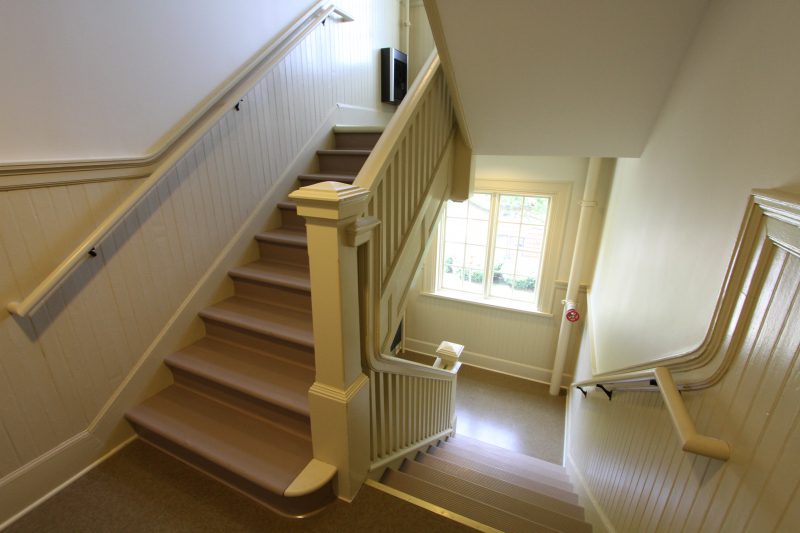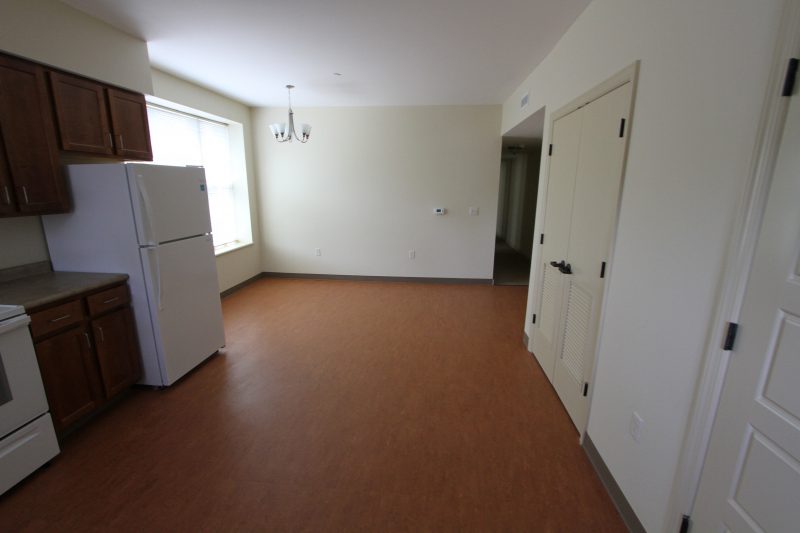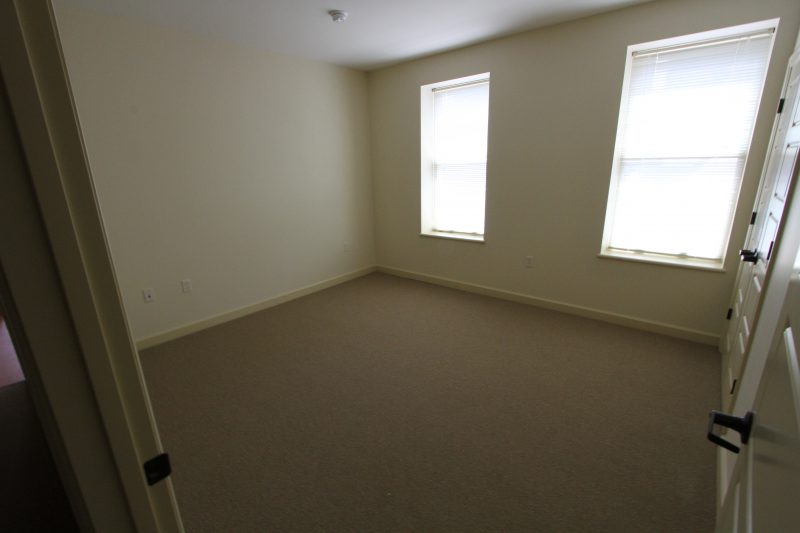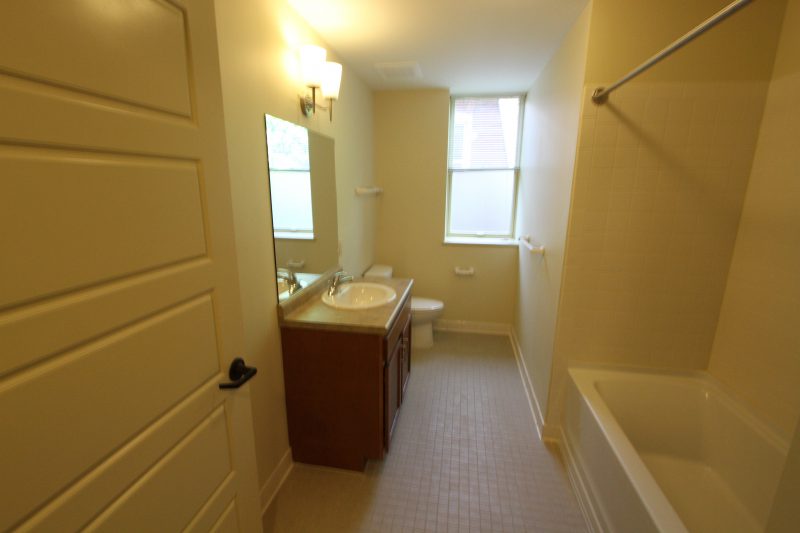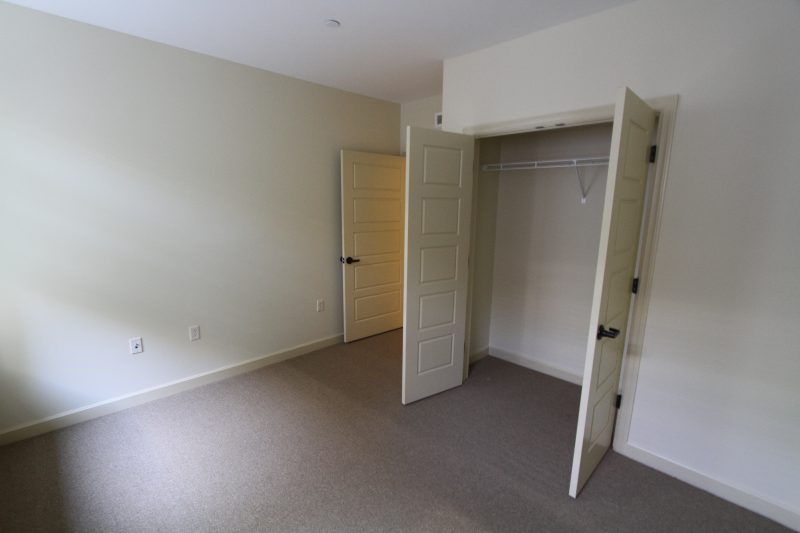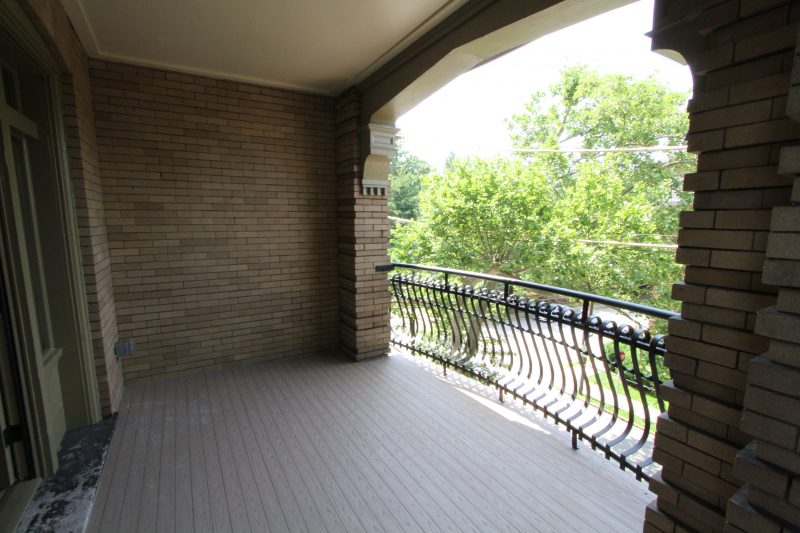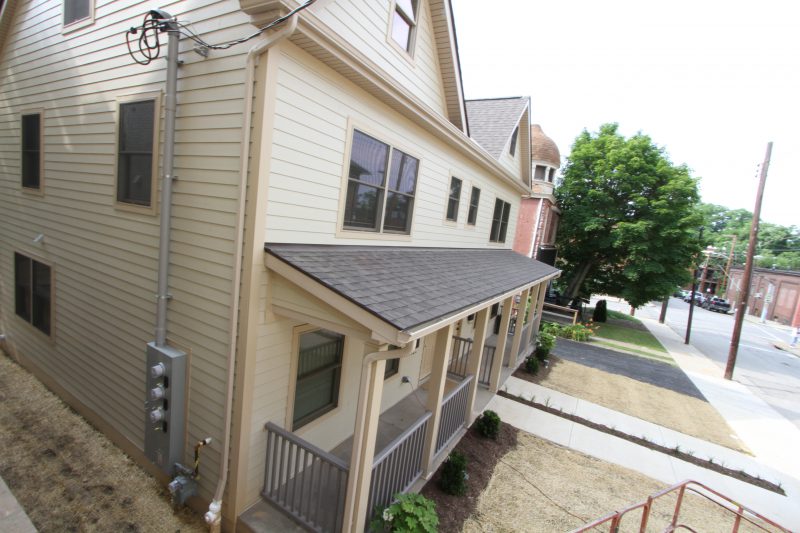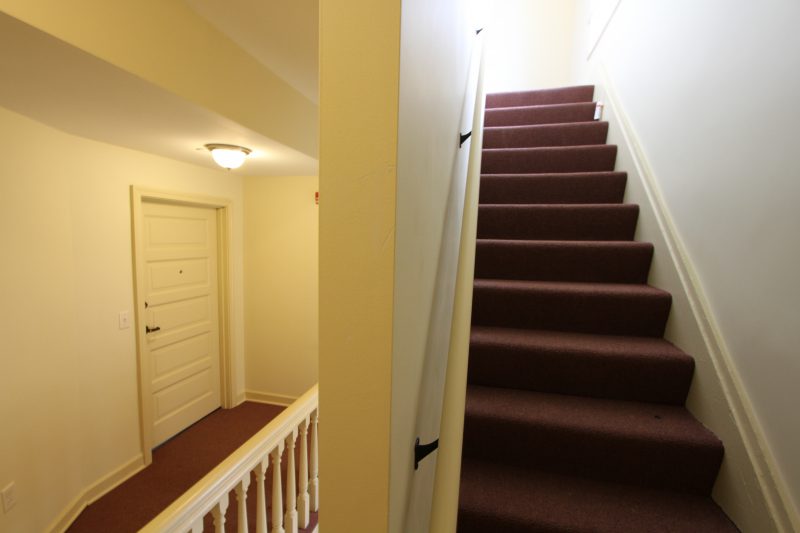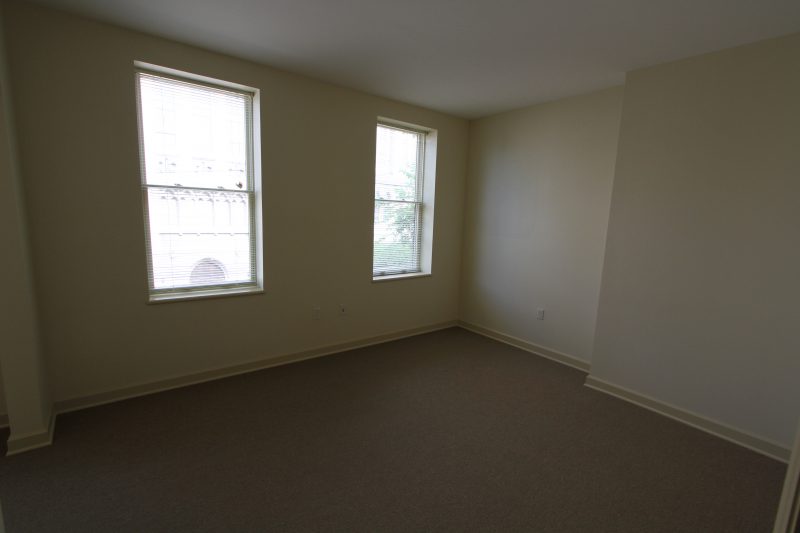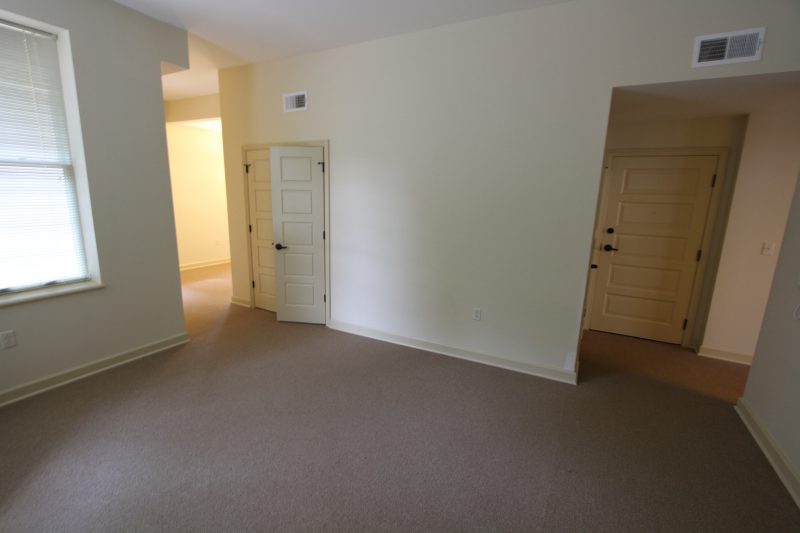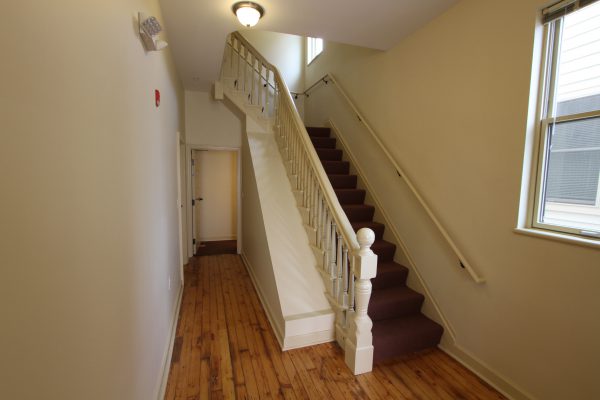
Category Archive: PHLF News
-
Wilkinsburg Boys and Girls Club Tours with PHLF
Below is a photo gallery of PHLF’s tour on August 9 with the Wilkinsburg Boys and Girls Club.
“We were able to offer this full-day tour aboard Molly’s Trolley––and many other tours this summer for young people––thanks to funding support from the McSwigan Family Foundation and Dollar Bank Foundation,” said PHLF’s Executive Director Louise Sturgess.
“This was an incredible experience for our students,” wrote one of the Wilkinsburg chaperones. “This type of program helps to educate children from every kind of ethnic and financial background. It serves to educate our children about the past, and that gives them purpose and direction concerning their future.”
-
Thank You Interns

Elyse Tuennerman (left) led PHLF’s Pokemon Go tour for young campers and families on August 10.
We thank Stephanie Springer and Elyse Tuennerman for volunteering at PHLF this summer. During her time with PHLF in May and June, Stephanie created fact sheets on the Courtyard by Marriott, Polish Hill, and the Woods family; listed PHLF on The Sprout Fund’s Remake Learning website; and photographed and helped with many school and membership tours.
Elyse volunteered in June, July, and August, providing terrific support for the Doors Open Pittsburgh event and helping with a variety of educational programs and tours. She developed and led PHLF’s first Pokemon Go walking tour, which was a great success for the young campers and families that participated on August 10.
“Stephanie and Elyse were a terrific help this summer,” said PHLF’s Louise Sturgess. “We thank each of them for volunteering and sharing their creativity and enthusiasm with us. We wish them much success in their studies abroad this fall.”
In reflecting on their internships at PHLF, Stephanie and Elyse shared the following comments:
Every day at PHLF was a new adventure, with tr
 eks to different parts of the city for tours, meetings, and events. I was given opportunities to take on projects that related to my interests in historical research and writing and constantly learned new things about Pittsburgh history and architecture. ––Stephanie Springer, Penn State University (History, Political Science, Middle Eastern Studies)
eks to different parts of the city for tours, meetings, and events. I was given opportunities to take on projects that related to my interests in historical research and writing and constantly learned new things about Pittsburgh history and architecture. ––Stephanie Springer, Penn State University (History, Political Science, Middle Eastern Studies) I am very grateful to have had this experience with PHLF, and am more motivated than ever to pursue a career in city planning after my summer here. Working with PHLF has exposed me to many different elements of preservation and community planning, from outreach and education to bricks-and-mortar development. Through this internship, I have fallen even more in love with Pittsburgh, its architecture, and its unique place in history. Thank you, PHLF! ––Elyse Tuennerman, Kalamazoo College (Anthropology, Sociology)
I am very grateful to have had this experience with PHLF, and am more motivated than ever to pursue a career in city planning after my summer here. Working with PHLF has exposed me to many different elements of preservation and community planning, from outreach and education to bricks-and-mortar development. Through this internship, I have fallen even more in love with Pittsburgh, its architecture, and its unique place in history. Thank you, PHLF! ––Elyse Tuennerman, Kalamazoo College (Anthropology, Sociology) -
100 Miles on Foot––and a New Perspective on Pittsburgh

No matter your age or where you go, touring with PHLF opens doors to historic places that contribute to the region’s vitality and beauty today.
By Elyse Tuennerman, PHLF Intern, Summer 2016
Having grown up in Ohiopyle, a tiny rural town (population 59!) in the mountains of Fayette County, my childhood experiences in Pittsburgh consisted mainly of isolated day trips. My family made the drive up to “the city” for special events––theatre performances, Pirates games, Fourth of July fireworks, and the like––but my understanding of how these different parts of Pittsburgh fit together, both geographically and conceptually, was limited. My knowledge of Pittsburgh’s architectural history was, too, limited—despite the fact that I have been a tour guide at Frank Lloyd Wright’s House on Kentuck Knob for five years, and that my mother is a local historian.
After walking over 100 miles on architectural tours, spending many hours looking over historical photographs and maps, and speaking with many fantastic and passionate Pittsburghers, I can say that my summer internship with PHLF has filled some of these gaps in my knowledge; my understanding of and appreciation for this city has grown immensely.
Attending summer walking tours has given me the chance to meet a stunning variety of people, from 5-year-old day camp children, to retired school teachers, to families visiting Pittsburgh for the first time. This has always been one of my favorite parts about being a docent at Kentuck Knob, and it was during my time at PHLF as well. Every group of visitors has their own unique perspective on a given space, no matter how many times you give the same tour. On our downtown tours, the youngest visitors were often the ones that most surprised me. One 6-year-old student in particular sticks out in my mind: he immediately noticed that the design in the carpet of the Union Trust Building lobby matches the pattern of the skylight above, something that took me weeks to figure out.
On PHLF tours, visitors are often reminded that, “the more you know about a place, the more you care about a place.” This certainly rings true for me. Over the course of the summer, I went from being completely unable to find Grant Street on a map to giving passionate accounts of its historic significance to any friends or family members willing to listen. As an aspiring city planner, it has been exciting and heartening to meet the many amazing PHLF staff members and volunteers who work so hard to foster an appreciation for our community and welcome discussion regarding improvement.
The list of places that I have called “home” is beginning to grow for me. This will be my last summer in Pittsburgh for some time as I prepare for a fall study-abroad experience in Aberdeen, Scotland, and then for continued undergraduate studies in Kalamazoo, Michigan. I am so glad, though, that this list started with Pittsburgh. This area’s built and natural environment are simply remarkable. I have been reminded of that every time an out-of-town visitor joined one of our tours, or a building that I was researching appeared in a book or article about exemplary architecture. My experience at PHLF has stirred up a sense of Pittsburgh pride in me that I did not know existed, and I am very thankful for it.
-
Demolition Doesn’t Work

Urban renewal saw the demolition of the U.S. Post Office Building in Downtown Pittsburgh in 1966.
A recent Wire News article out of Detroit reported how a two-story wood frame house became the 10,000th building to be demolished as part of that city’s plan to eliminate blight. Described as “another win in a years-long battle to improve Detroit neighborhoods,” the demolition was part of a 2014 task force recommendation to tear down some 40,000 structures, with another 38,000 yet to be designated for demolition.
Detroit is not alone. In January, the City of Baltimore rolled out a plan to demolish some 4,000 structures over the next four years with the aim of cleaning up blight and preparing its neighborhoods for redevelopment and investment.
We have seen this before, city leaders turning to demolition in the hopes that it would lay the groundwork for broad community reinvestment in the form of new housing. However, the record is clear that demolition hasn’t worked when considering meaningful urban renewal in our neighborhoods, our cities, and our towns. There is now almost 70 years of evidence that it doesn’t work.
Massive demolition hollows out neighborhoods and leads to a loss of neighborhood identity and building density. Once buildings that could have been restored are gone, they are lost forever. It happened here in Pittsburgh, when at the height of the same urban renewal and planning policies, the city demolished entire swaths of the North Side, Hill District, and East Liberty.
Our organization was formed in 1964 in Manchester because people were concerned that the city was losing too much. Where we joined with residents and succeeded in fighting demolition—from Liverpool Street to the Mexican War Streets, Central North Side, South Side, Downtown Pittsburgh, Wilkinsburg, and other areas—we see today what has become some of the most desirable mixed-income and diverse neighborhoods in the city because of the preservation of historic buildings.
Where demolition went ahead on the North Side, the historic lower Hill District, and in East Liberty, we saw the failed public housing, shopping malls, and commercial areas that replaced what were once solidly built, architecturally rich, and culturally diverse neighborhoods filled with local businesses. Indeed, these same areas are now the focus of government and development agencies, which must spend significant public funding to create housing in spaces that have been empty for more than half a century or to demolish publicly-supported housing that replaced historic buildings.
The evidence is abundant. Demolition has not been a viable means of creating neighborhood revitalization in Pittsburgh and across the nation. In fact, in Wilkinsburg, Pennsylvania, where we have been engaged in a broad restoration initiative, we have found that empty and abandoned vacant land created by demolition has led to more tax delinquent land parcels.
Many of you might have read Paul Graham’s excellent article in the Pittsburgh Post Gazette’s July 10 issue, “How to Make Pittsburgh a Startup Hub.” One of the key points he made was: “When cities are on the way back up, like Pittsburgh is now, developers race to tear down the old buildings. Don’t let that happen. Focus on historic preservation. Big real estate development projects are not what’s bringing the 20-somethings here. They’re the opposite of the new restaurants and cafes; they subtract personality from the city.
“The empirical evidence suggests you cannot be too strict about historic preservation. The tougher cities are about it, the better they seem to do.”
Preservation has worked for much lower economic cost and less displacement of the people. In Pittsburgh, we are fortunate to enjoy civic and political leadership that understands the significance of preservation as a means of economic and community development.
Arthur Ziegler
President
Pittsburgh History & Landmarks Foundation -
McSwigan Family Foundation Grant

PHLF led students and youth counselors in Camp Downtown 2016, hosted by First Lutheran Church, on two walking tours in June. Campers spied “The Two Andys,” a mural by Tom Mosser and Sarah Zeffiro on Wiener World, as they walked down Strawberry Way, featuring “City Composition,” the new street mural by Deanna Mance.
PHLF does tremendous work educating the community and young people. This work fills a historical void in the city. ––Hampton Middle School Teacher
A grant in the amount of $32,500, awarded by the McSwigan Family Foundation in June, will help underwrite PHLF’s educational programs with young people and its Landmarks Scholarship program. “This is terrific support,” said PHLF Executive Director Louise Sturgess, “and is so essential to the success of our programs. This funding support makes it possible for us to keep our school tour fees affordable, initiate new programs, and continue our popular architectural design challenges, poetry and art workshops, career awareness presentations, Portable Pittsburgh artifact kits, and Architectural Apprenticeship.”
Through its award-winning, interdisciplinary educational programs, PHLF turns the Pittsburgh region into a classroom for learning for more than 5,000 students and their teachers each year. By involving young people in exploring local history and architecture, PHLF is able to encourage a preservation ethic and promote character development, community awareness, citizenship skills, and a sense of belonging. In the process, students strengthen critical thinking and problem-solving skills, explore historic places, embrace diversity, expand their imaginations, and develop hometown pride. As one Pittsburgh Public School teacher noted after her students participated in a poetry and art field trip:
Students are much more engaged when they get to learn outside the classroom. Being away from school levels the playing field for kids of different abilities and allows those that don’t normally excel to demonstrate their strengths. It also gives kids whose parents don’t necessarily have the time or ability to expose their kids to the city’s riches a chance to see and experience them.
We thank the McSwigan Family Foundation for partnering with us in our educational programs.
-
City of Pittsburgh’s Bicentennial Parade in Photos
In the gallery below are photos of the City of Pittsburgh’s Bicentennial Parade on July 9, proceeding along Liberty Avenue from 11th Street to Point State Park.
-
Scholarship Celebration: A Most Memorable Evening
 Leroy Dillard, a member of the Landmarks Scholarship Committee, and his wife Gwen, hosted an inspirational reception at their home in the Hill District for PHLF’s newest and former scholarship recipients and other invited guests. Everyone enjoyed an incredible view of downtown Pittsburgh and the Allegheny River Valley on a picture-perfect evening. Leslie Ezra Smith welcomed the group by reading a poem he wrote about the Hill, and the Pittsburgh Cultural Arts Collective’s African drum and dance groups, founded by Thomas Chatman, performed while people enjoyed a delicious soul-food dinner. For more photos, see our Facebook page.
Leroy Dillard, a member of the Landmarks Scholarship Committee, and his wife Gwen, hosted an inspirational reception at their home in the Hill District for PHLF’s newest and former scholarship recipients and other invited guests. Everyone enjoyed an incredible view of downtown Pittsburgh and the Allegheny River Valley on a picture-perfect evening. Leslie Ezra Smith welcomed the group by reading a poem he wrote about the Hill, and the Pittsburgh Cultural Arts Collective’s African drum and dance groups, founded by Thomas Chatman, performed while people enjoyed a delicious soul-food dinner. For more photos, see our Facebook page. We congratulate the following four high-school graduates who were awarded scholarships in the amount of $6,000 (payable to the college/university over four years for book and tuition expenses):
- Benjamin Finnstrom, from Pittsburgh CAPA, who will be attending the University of Pennsylvania and studying architecture;
- Jacob Seiler, from North Hills High School, who will be attending Penn State University and studying engineering;
- Aaron Smolar, from Pittsburgh Allderdice, who will be attending Washington University in St. Louis and studying architecture; and
- Kevin Stiles, from North Allegheny High School, who will be attending Carnegie Mellon University and studying computer science.
In addition, we congratulate four more high-school graduates who were awarded honorable mentions (a one-time gift of $250 payable to the college/university for book and tuition expenses):
- Remy Erkel, from Winchester Thurston, who will be attending Haverford College and studying mathematics;
- Mitchell Ford, from South Fayette High School, who will be attending the Catholic University of America and studying architecture;
- Jeewon Lee, from North Allegheny High School, who will be attending the University of Pennsylvania and studying biochemistry; and
- Genevieve Nieson, from The Ellis School, who will be attending the Pratt Institute of Art and Design.
“We welcome these eight new winners to our remarkable group of Scholarship recipients,” said David Brashear, founder and chair of the Landmarks Scholarship Committee. “I am continually impressed by the type of people who grow up in Western Pennsylvania. Pittsburgh is a humble place, and self-promotion and large egos really aren’t part of the regional DNA. But I believe there is value in recognizing that someone has something to contribute and that their efforts have been appreciated. I think our scholarship winners have shown that they take our recognition in a very positive way, and become better people because of it.”
Since PHLF began awarding scholarships in 1999, many of the recipients have graduated from college/university and are employed or are pursuing further education. “We have scholarship alumni working in the fields of architecture, business, construction, engineering, development, and medicine, among other professions,” said PHLF Executive Director Louise Sturgess. “One student is pursuing a PhD program at the University of Pittsburgh in Environmental Engineering, while others are pursuing studies or working in Austin, Boston, Chicago, New York City, California, Germany, and Scotland. Two former recipients are now trustees of PHLF––Kezia Ellison and Todd Wilson––and each recipient stays in touch with PHLF and continues to care about this region.”
PHLF’s scholarship program is funded by generous contributions from the Brashear Family Named Fund and by donations to the Landmarks Scholarship Fund, including contributions to the 2008 and 2014 Scholarship Celebrations.
We welcome the support of our members and friends to help us sustain this program. To contribute, please click here (and designate your gift to “Scholarship Programs”) or contact Mary Lu Denny (412-471-5808, ext. 527). Thank you very much.
-
Wilkinsburg Buildings Restored
PHLF has completed restoration—including new infill construction—of townhouses and an apartment building in Wilkinsburg, as part of an $11.5 million neighborhood development program to create more quality affordable housing in restored buildings.
The buildings include 608 Mulberry Street, a wonderful brick building with character, which will offer three family apartments, one on each floor. Two adjacent townhouses, 604-606 Mulberry, are new buildings that replaced a structure which could not be saved. The townhouses, which are located across the street from St. James R.C. Church, have off-street parking in the rear.
At the intersection of Rebecca Avenue and Coal Street, we have completed the restoration of an eight-unit brick apartment building, which will be known as the Columbian Hall Apartments, which we discovered was the building’s original name.
Leasing by NDC Real Estate Management is currently underway and ahead of schedule.
Still under restoration construction is a building at 520 Jeanette Street, which will include two family apartments and the Falconhurst Building, a red-brick apartment building located at 724 Kelly Avenue.
In the gallery below are some before-and-after photos of the houses and the interiors of the units.

